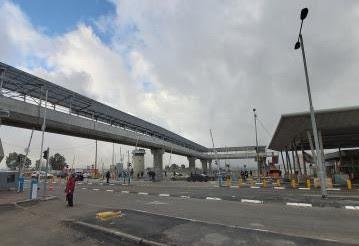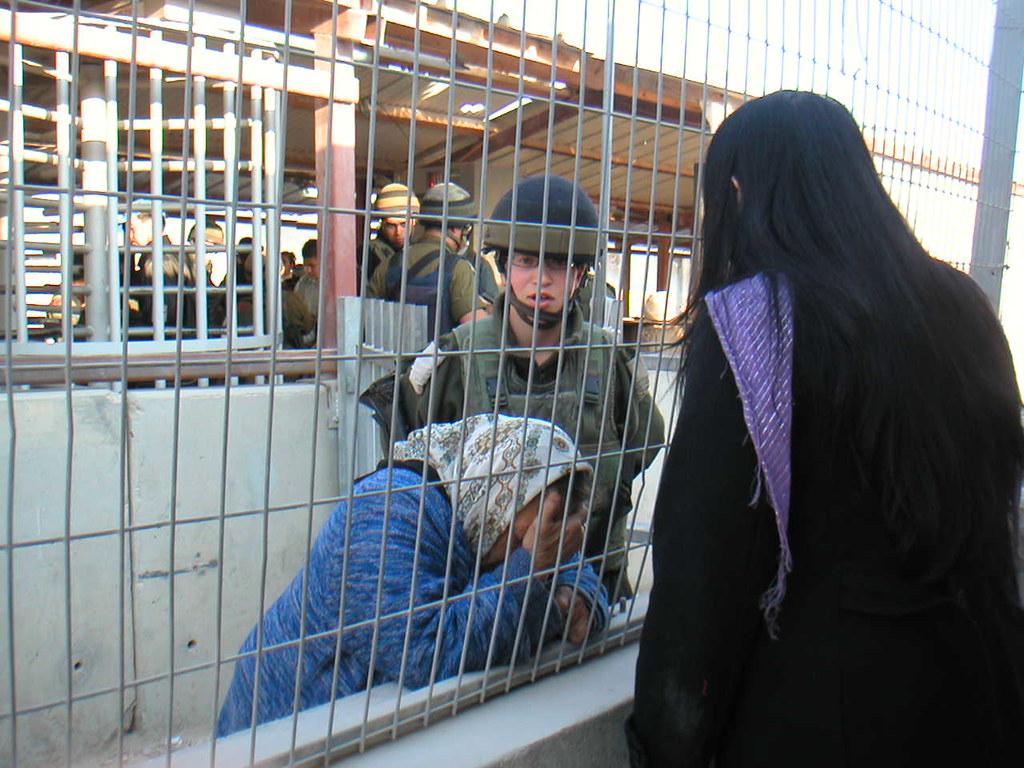The Qalandiya Checkpoint is the main entrance to Jerusalem for residents of Ramallah and the northern West Bank. It is located in the separation wall, amidst Palestinian neighborhoods, far from the Green Line. We were there when it was established in 2001 as a temporary post. We regularly checked on Palestinians crossing to Jerusalem, the center of most of their activities. We monitor it now, as the renamed “Atarot Crossing," equipped with quick electronic identification devices, and many more checking terminals.


At the end of the 1960’s I immigrated to Israel from South Africa. I grew up with apartheid as a fact of life, and I wasn’t a political activist neither there nor in Israel. The first day that I ever went out with MachsomWatch…hard to believe it was nearly 20 years ago, was a rainy miserable day and we went to Qalandiya. I was completely bewildered. It was filthy, the traffic like the wild west, rubbish all over, people rushing, trying to make their way through the confusion and mud to two small army posts for people to go through. (Natanya G., MachsomWatch member)
At the beginning of the 2000’s, young confused soldiers stood in the improvised checkpoint and determined fates: who will get to their work today, to a clinic, to visit their family, and who will not get to their destination. People squeezed into the checkpoint, there were cases of violence and sometimes, pregnant women were being delayed. There were heart-breaking scenes, and in particular, there was a feeling that a herd of animals was being pushed through a narrow gate…. When the separation wall was completed in 2005, 20,000 Jerusalem residents were left behind it. Since then, they too have to wait at the checkpoint for long hours each morning to reach their schools, offices and other places of work, which they used to reach within minutes.

The years passed, structures were added and stuck to one another; very narrow carousels and “animal cages” where the multitudes were squeezed, were wire-fenced from the floor to the roof. The place was overcrowded and the wait in line lasted many hours. Men, women and children were crushed and wounded. Young men climbed the fences to bypass the lines, and when a person finally squeezed into checking cells, armored glass prevented any human contact with the inspectors.
Year after year, behind the scenes, the bureaucratic barrier of entry permits grew higher and higher. Only a Palestinian who managed with hardship and sweat to receive a specific permit, limited in place and time, was allowed to cross the checkpoint from the northern West Bank into Jerusalem. Qalandiya became the essence of the hell that Palestinians have to cross on their way to Jerusalem for anything they need: work, health, religious worship or family gatherings. And we, in MachsomWatch, watched, documented, publicized and at times tried to assist, overwhelmed by shame and pain.
In mid-2019 the new checkpoint building was finally opened. The halls were enlarged, many metal detectors were installed for security checks. After passing them, people are directed to electronic self-identification stands, which they pass with an all-knowing magnetic identity card and facial identification. The passage is usually fast, a real improvement! But the bureaucratic barrier has been upgraded: the new electronic checking allows for close and invasive tracking, and thus deepens the control of the lives of those crossing by limiting their permits and by other means.
Even in the technological upgrades and in the new building and the approach to it, the worsening of conditions and the contempt for the users are evident. Sometimes it ends in injuries: Two Palestinians with hearing disability were shot in 2020 because they couldn't find the pedestrians' entrance and went directly to the vehicle crossing instead. They didn't hear the warning calls of the security guards and were shot.
In late July 2020 we arrived again at Qalandiya after an absence of some months. We were filled with horror when we saw the new bridge above the vehicles passage, which is now the only access to the pedestrian checkpoint. We find it hard to understand how a walk of a few meters to enter the old checkpoint has been converted into a winding, steep, convoluted, unfriendly concrete ramp. How can anyone in a wheelchair, a woman with a pram or the middle-aged possibly deal with this challenge?... And more - the foot entrance to the checkpoint from the north, the direction of Ramallah, is so unclear that it is no wonder that those who do not know the place tend to go directly to the death trap, past the vehicles. The mute deaf man who made this mistake is a striking example of this situation. Later in the scene, we spoke with a security company man who confirmed, albeit embarrassingly, that our diagnosis was correct - "really sad" in his words ... (Netanya G. and Hannah B., from Qalandiya reports from July and August 2020)(From the Qaladiya report, July and August 2020 by Natanya G. and Hanna B.)
And finally, as technology (still) relies on the human factor, it too has weaknesses and failures. Such failures we observed recently, as many of the stands for checking belongings and for electronic self-identification were not operating due to technical failures and to a shortage of manpower to supervise them. And so the old sights return: the collapse of line-ups, the unbearable overcrowding (yes, during the COVID-19 pandemic), and young people trying to jump the fences. A mess and human suffering.
The Qalandiya Checkpoint is a testimony to the fact that the occupation is adjusting and upgrading itself. But when the real objective is the more efficient control of the occupied population and keeping it out of Israel and away from areas it intends to annex, one can only make a “cosmetic facelift," and even this turns out not to be very successful.
